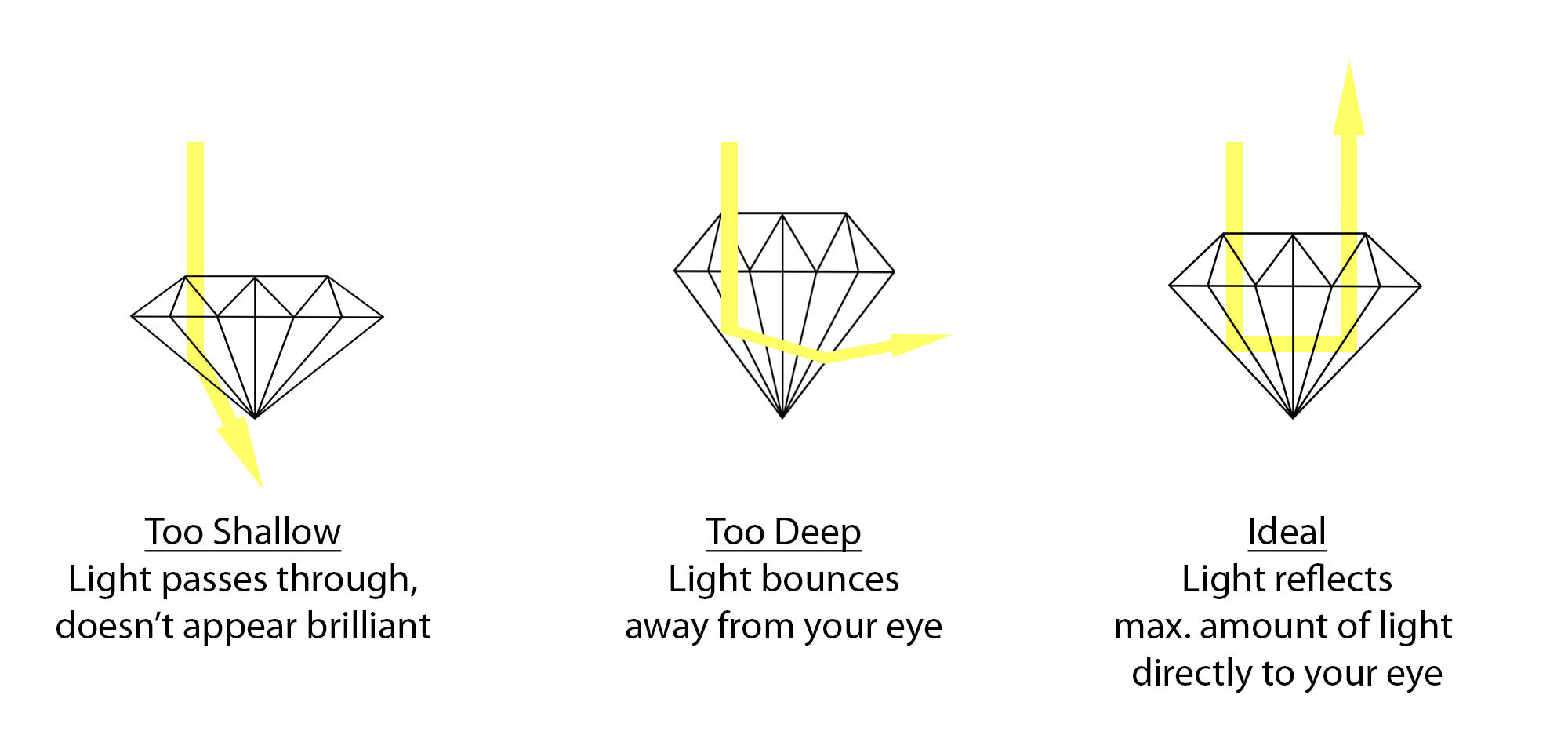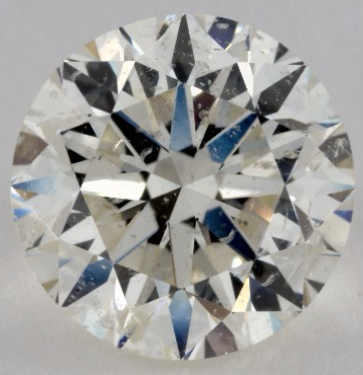Your Cart is Empty
FREE SHIPPING ON ALL DOMESTIC ORDERS
Have you heard of the four "C's"? Cut, color, carat, and clarity? Maybe you've heard these terms being thrown around but do you feel comfortable about what they are and why they matter? Before you fork over thousands of dollars on a ring, make sure you understand the basics. There are whole textbooks written about diamonds and their various properties, but if you only have a few minutes, here's what you need to know.
This might go without saying, but diamonds are like snowflakes -- no two are alike. Not only do they come in different shapes and sizes, but their internal properties can have large variation. Some are whiter than others, some are more yellow or brownish. Some are crystal clear, others are cloudier. Some are proportioned in ways that make them sparkle with tons of brilliance, while others can appear duller by comparison.
In order to make sense of it all, it became necessary to come up with a standardized way of grading each and every stone. When a stone gets certified by a reputable establishment, such as the Gemological Institute of America (GIA), they are evaluating these four main parameters.
Cut is number 1 for a reason. The other three C's are important, but when it comes to the overall look of the diamond, nothing matters as much as the cut.
A diamond's cut essentially describes how well proportioned a particular stone is. This is NOT to be confused with SHAPE (round, square, pear, emerald, marquise, etc., are shapes not cuts). By cut we're talking about things like symmetry of the stone, or whether the top or bottom is cut too deep or too shallow.
A poorly cut diamond can appear darker or not as brilliant, while a stone with an excellent cut grade will appear radiant and bright.

There's more to it than this, but hopefully you start to see the importance of having a quality cut. You don't want to see dark spots or other undesirable reflections.
When deciding on a diamond, you'll want one that has at least a "VG" (very good) or if possible an "EX" (excellent) cut grade. (In some instances "ideal" is used in place of "excellent")
If you're looking for more technical information, I invite you to explore the GIA website. For now, the important thing to know is that you want to avoid a diamond if it has a poor cut grade.
This one's easy to explain. The more colorless or white a diamond is, the more scarce it is. The more scarce, the more valuable.
You might shudder at the thought of once receiving a D, E, or F grade in high school, but if you own a D or E diamond you're sitting pretty. You can't do any better than a D color grade, which means it's completely colorless.
And as you go down the scale, you'll definitely start to see some differences.

Courtesy - GIA. Notice how when evaluating a diamond's color, it's always best to look at it face down. This is so you can focus on the color without being "blinded" by the sparkly brilliance of the facets on the crown of the stone.
But I'm going to let you in on a little secret. Even if you have a certified diamond that boldly says it's, let's say an F color, these color grades are not as objective as you may think. That's because the letter doesn't directly refer to an exact COLOR, but rather a color RANGE. Some F's look almost like an E. Some F's look almost like a G. Some G's can look like H's, and so on.

Courtesy - GIA. Note: Even though I, J, K, and L stones definitely start to show a hint of yellow, you can save money and set them in a yellow gold band. The stone always picks up some light from the metal, and the yellow tint won't be as noticeable as it would be in a white gold or platinum setting.
The main point here is that there's always going to be some degree of subjectivity when looking at diamonds, and there's nothing wrong going higher or lower on the scale if you desire to. Nor should you get too caught up on 'settling' for G because you couldn't afford an F. If your goal is to get a very white diamond, but you don't want to break the bank, something in the F-H range would likely suffice. To the untrained eye, you're likely to only spot a difference when placed directly next to a D or an E.
Of the 4 C's, carat is probably the most commonly understood. Carat is not to be confused with karat - a term used to describe the purity of gold. Carat is the unit of measurement used to describe the weight of a gemstone.
1 ct = 200 mg
In comparison to cut, color, and clarity which are subjectively graded, there's no debating the carat weight of a stone.

The larger the diamond the more expensive it tends to be (with all other things equal).
But when looking at the value of diamonds, the total cost of a stone can be deceiving as it pertains to carat size. That's because you need to look at the cost per carat. Check out this example mentioned in Renee Newman's book, Diamond Ring Buying Guide:
| Weight | Total Stone Cost |
| 1.00 ct | $6,000 |
| 1.20 ct | $7,080 |
| 1.30 ct | $7,540 |
This might look self explanatory but it doesn't tell the whole story. It's more revealing to compare values by looking at the per carat cost of the same diamond.
| Weight | Per Carat Cost (total cost / ct weight) |
| 1.00 ct | $6,000 |
| 1.20 ct | $5,900 |
| 1.30 ct | $5,800 |
As Newman points out, "normally, the 1.30 ct diamond should cost the same or more per-carat than the other two stones. However, in this case, it costs less. Consequently, the 1.30 ct stone is the best buy".
Diamond pricing can get a little complex. The larger the carat weight the more expensive, but not in a linear way. The price jump from a 1 ct stone to a 1.5 ct stone is much more of an increase than going from .5 ct to 1 ct.
If you remember one thing from this article it should be that carat weight isn't the be-all and end-all. You really need to factor in the cut, color, and clarity and find a balance.
Clarity features refer to blemishes (external marks) and inclusions (internal features) found in a diamond.
When diamond shopping or looking at a GIA grading report, you may have heard or seen words like crystals, cracks, fractures, feathers, cleavages, clouds or grain lines used to describe a diamond's clarity.
At first glance you might think that it's bad to have these "flaws" but that isn't necessarily the case. Yes, stones with fewer inclusions are more expensive but that doesn't mean you won't be happy with one with a lower clarity grade. Not only will you be paying less money, but these marks are like your diamond's fingerprint signature. It's proof of it being an authentic, natural rock and in most cases will not affect how your diamond looks to the naked eye.
Look at this grading chart for clarity grades.

If I were to tell you that a diamond had the 7th or 8th best clarity grade, would you be interested in buying it? If you said no you could potentially be overlooking a very very good diamond.
Not only are clarity grades subjective (a one grade difference between two expert graders isn't uncommon), but grades as low as I1 requires 10x magnification in order to be judged properly. That's why SI1 and SI2 can be wonderful diamonds.
| A 1.5 ct diamond, SI2 clarity at 20x magnification. | The same diamond at scale. |
 |

|
Inclusions can be an issue if there are flaws that make a diamond less attractive or vulnerable to chipping, but don't be fooled into thinking you need to pay a premium for a VVS1 or VVS2 diamond. I'd rather have an excellent cut, E color, SI1 diamond than a poorly cut stone with a higher clarity.
With that said, if I'm choosing between SI2 stones I look to look for where the inclusions are located on the face of the diamond, and if they are white or black. In many cases, the inclusions are not in the middle and will be covered by the prongs once set in the ring.
The 4 C's are critical to be aware of while shopping for an engagement ring. While carat weight is important, please don't overlook cut, color, and clarity. These nuances become much more pronounced on solitaire rings.
At Giacomelli Jewelry, we prioritize the cut quality so that our customers get the most brilliance and fire. Our belief is that diamonds are only as unique and attractive as the rings they are set in. That's why we offer a stunning lineup of creatively designed settings.
Engagement rings don't even have to be diamonds either. Learn about alternative center stones.
Did this article help you out? Let us know what you think. Email us with any questions or comments at info@giacomellijewelry.com.

